 |
| Bullet Trains – A Way of Life |
Bullet Trains solve lots of issues. Speed, for one. Why won’t the US invest in them? The rider arrives quickly and on time. The lines look long, but get through the automatic ticket taker in a wing flap and in 25 minutes we had covered what would take an hour and a half on the road. This was a short day trip to Suzhou, a 2500 year old city known for its gardens and “scenic beauty” as a classic Chinese city and as the Venice of China.
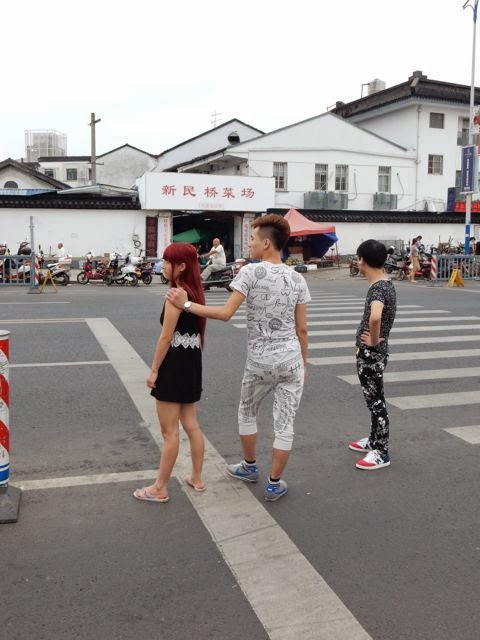 |
| Youth in Sozhou |
Suzhou translates into: “Su” – fish and rice and “Zhou”, bridges and canals and that covers the experience. It seemed to me a city catching up with the rest – the proverbial tall apartment buildings bunched together, and construction everywhere as well as traffic confusion. The highly touted Garden of the Humble Administration is considered one of the four superstar gardens in China, the others being the Lingering Garden, the Summer Palace and the Bishushanzhuang at the Imperial Hunting Park in Chengde. There are two types of gardens in China, the imperial ones for the emperors to enjoy, and private residential gardens built by scholars, the wealthy merchants and government officials. This was of the second sort. Public welcome.
 |
| Garden view |
The ten acres of the Garden of Humble Administration was packed with families wandering the pebbled paths, which have the double benefit of getting you there and massaging your feet on the way. It was the usual gray day, and we wandered from the East garden to the West garden (division of gardens into sections seems the norm) and through big Moon circles, footbridges, a few pagodas, and, if one wanted, up a string of rock stairs to lookouts. A tall pagoda a mile away, seemed to be close as my hand.
 |
| Humble Garden |
There are two kinds of rocks, I was told by the guide: the enormous low, spread out darkish kind of rocks are considered male, they usually line pathways; and the tall crooked and peak looking rocks which are female. (Does that make a difference?) Poets are said to wander here and read their poetry, and families with their one-child in tow seemed to enjoy the greenery and particularly a section with ancient bonsai. It all seemed compact to me with plenty of pines and camphor trees and magnolias and gardeners trying to keep things up to par. Giant lotus leaves stood up in ponds and after wandering in curls and ques one realizes we had been covering the domain of a former Emperor’s home. Each category of room, dining, bedrooms, lounge rooms, reception rooms, all in the black ornate style of framework with pagoda roofs, were separate from each other. If it rained, you stayed in or got wet getting to breakfast, I guess.
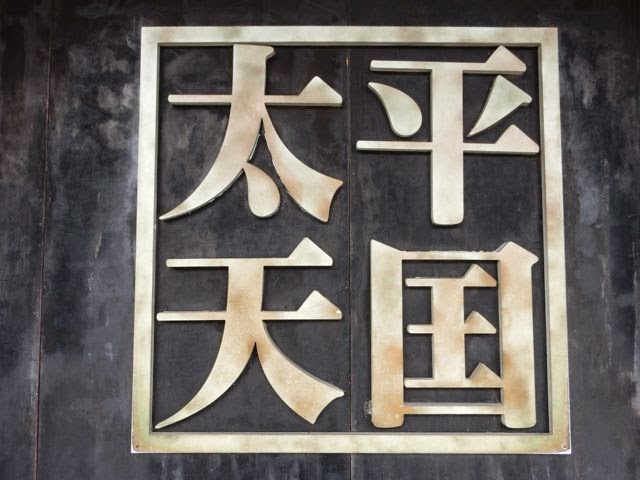 |
| Heavenly Kingdom |
Toward the end, we found in the Dragon Head building, the statue of Hong Xiuquan, leader of the Taiping rebellion that exterminated 20 million Manchus. There stood his handsome bust showing the whims of the young man who wore a simple red jacket and who claimed he was the “Son of God” (with all that blood?) He, apparently, founded the Heavenly Kingdom, large characters of which are on the wall to remind guest this was the place. He was known for his simple cape and cap, red, without the ornate essentials of emperors. The fanatical Taiping, known for ethical edicts outlawing foot binding and opium, and their radical social framework, walked right into the fold of the Communist revolutionary visionaries and nurtured the paranoia that is still present today in certain cities, but not Shanghai.
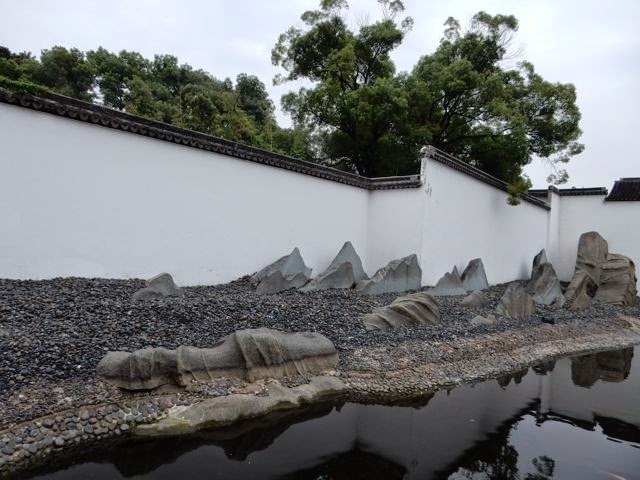
 |
| Self Made God |
 |
| Samples of Jade |
Tight up against this “humble” garden is the last architectural structure by Chinese-American I.E. Pei, whose family is from Suzhou, the new Suzhou Museum. I.E. Pei, in his hundreds, lives in the US. Typically there were walls of giant boulders and white plaster walls, lots of angles, pyramids, squares and abundant light – just as humble as the garden next door – but it was under repair with scaffolds and construction workers marring the view.
The museum keeps safe a number of ancient Suzhou artifacts, like bronze mirrors (back in the day they were so polished that you could see yourself in them – looks impossible to me), and lots of jade in colors I never imagined like beige, white, brown. Lunch in the 250 year old local restaurant Song He Lou, included buns, vegetables like Ti Cai (a soft spinach puree sort of), lotus root, Mandarin fish (always with bones, ugh) and a cold sweet tea, which is odd because Chinese do not drink anything icy cold, and we shared with the neighboring table. We left a lot of food on the table, because Chinese don’t cook for three but for ten, every time. There is lots of meaning in numbers.
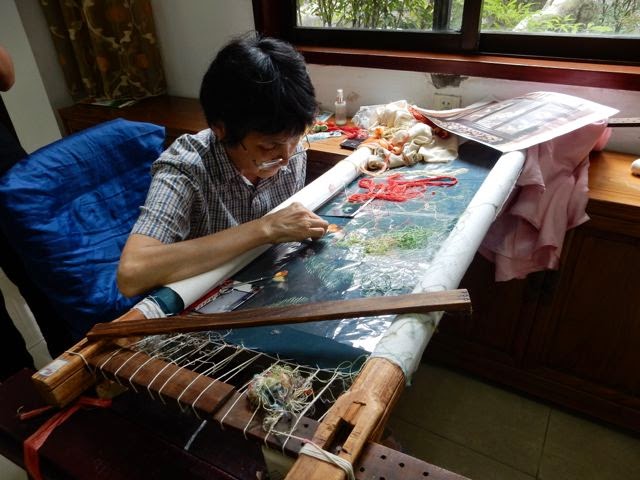 |
| Master Embroiderer |
Next stop was what I really came here to see: the Silk Embroidery Research Institute where embroidery has been practiced since the Tang Dynasty (618-907) – it’s hard to get the dynasties in order. Suzhou is a center of the silk industry from mulberry tree to final product, but breath taking is the work done by master embroiderers who spend five days a week bent over their frames, separating silk threads into single strands finer than a baby’s hair strand, it’s even hard to see unless against a dark background.
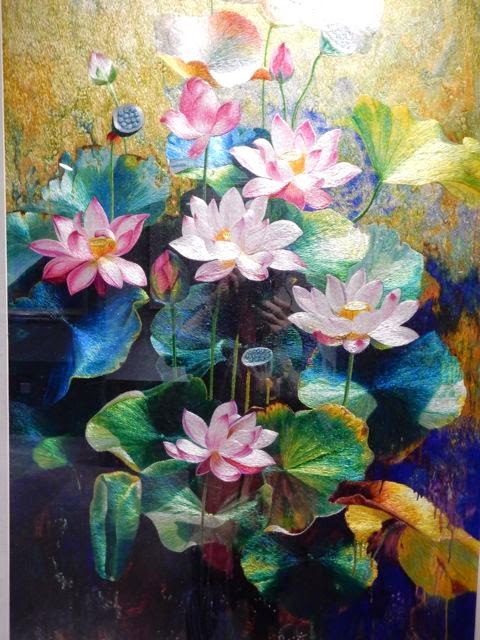 |
| Lotus Embroidery |
Somehow they thread the thing and are able to create layers and layers of textures to form amazing flowers, landscapes, animal portraits, and the specialty of this institute, cats and fish. There are four embroidery institutes: one in Canton called YueXiu where peacocks and hibiscus are the best; Xiang Xiu in Hunan, where lions and animals are their best subjects; and Shu Xiu Province where gold and silver landscapes stun the imagination. We wandered through a small gallery with extraordinary pieces like Mona Lisa and a portrait of Mao ZeDong which moved from old to young as you walked past it. (No photos allowed).
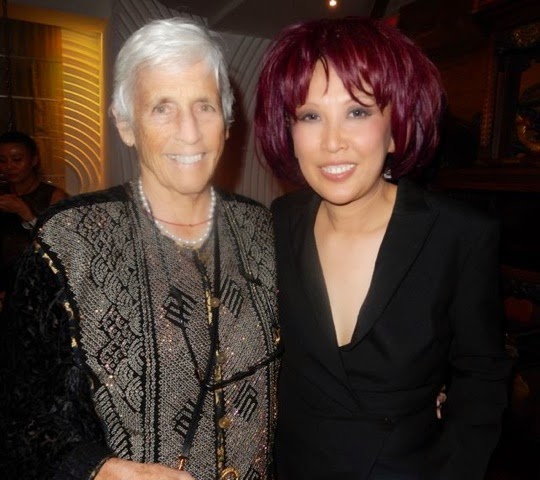 |
| Pearl Lam |
In the work room, masters, teachers and students were bowing over their frames – one piece usually takes up to a year to finish. Speed is the enemy. Error is unforgiving. I asked if the women (men don’t do this apparently) received much money for their pieces which sell for 30 to 50 thousand dollars and more when completed by a master, but received a vague answer. It takes five years of training to be able to turn out a piece that is put in the shop for sale. At the end is the huge room of “products for sale” while a guide doesn’t give up trying to convince you to buy anything you comment on from the most expensive set in ornate Oriental frames, and sometimes two sided, to small pieces by students, which sell for about 25 dollars. I said “No.”
 |
| War Painting at Lam |
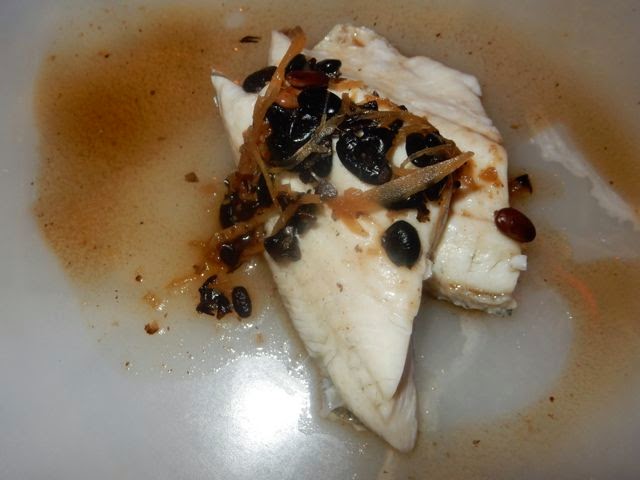 |
| Fish Dish at Mme Lam’s |
My feet were killing me, and we were able to get a bullet train back to Shanghai earlier than planned and our trusty “Jay” guide was there to make sure we were safe. I squeezed in a foot massage at the hotel spa, in preparation for a night in a new world for me – a dinner party by the hostess with the mostess, Pearl Lam, art queen and collector living in Shanghai in a glorious apartment 23 floors up in a building she owns. She was entertaining the trustees of the New York Philharmonic and high rolling investors here on a tour to arrange an event combining the Philharmonic and the Shanghai symphony in July 2015. This is an amazing accomplishment and Ms. Lam is one of the instigators. Three floors of her home are filled with the best of Chinese post-revolutionary art and she owns an art gallery, which I visited my first day here.
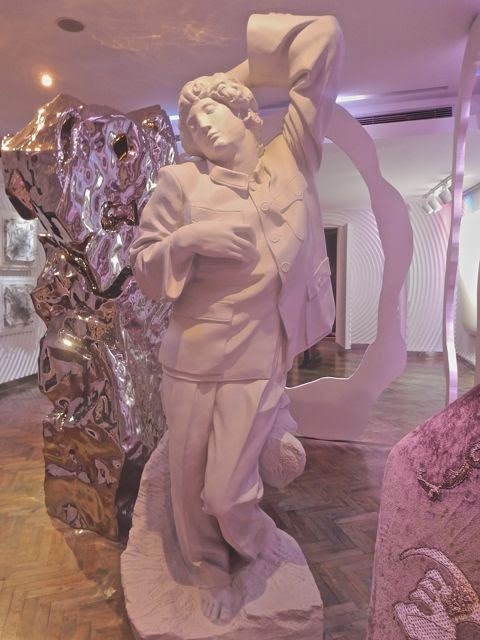 |
| Shanghai “David” at Mme Lam’s |
The dinner was at a lacquered table as long as those you see in reports of Royal Dinners (can’t see the other end), and it was outfitted with ceiling high flower creations and white dragon candlestick holders, and white ceramic hands sitting in front of me to hold first the napkin and then two rounds of dinner. The lighting was pinks and purples and the guests (probably about 40) were alive, exciting and from all over the world: architects, philanthropists, the U.S. Consulate, the director of the Philharmonic, Fashion designers, business entrepreneurs, art experts and collectors, and opera stars and me. The conversation was lively but the meal a work of art – every course, 6 of them, was white on white – a white chicken broth, white fish with truffles, white mushrooms, white gluten puffs filled with sugar and rice floating in a white milk soup. Yes! Each course was served in unison by a bevy of waiters and there was a huge maitre’d, I guess (looked like a bodyguard), who rang the gong to get us to sit down. Madame Lam was present from the time I arrived til departure at midnight. It was a happening.














